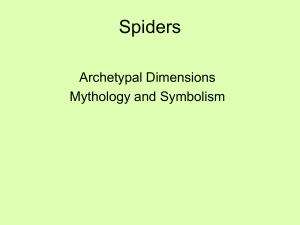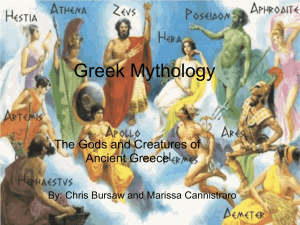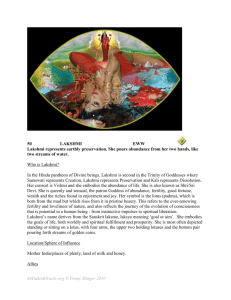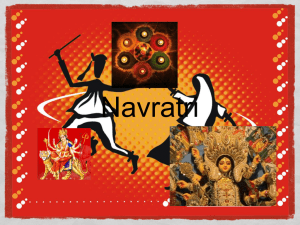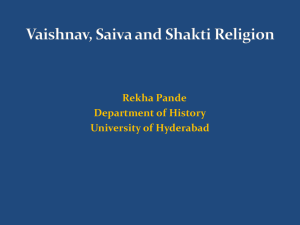Lesson 4
advertisement
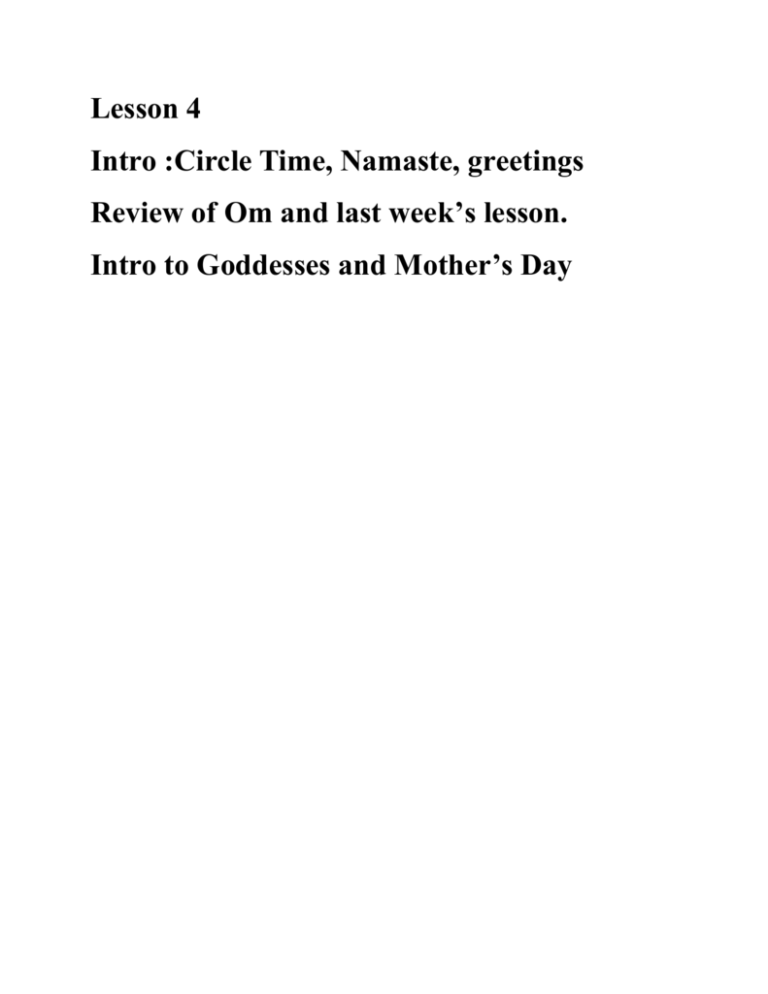
Lesson 4 Intro :Circle Time, Namaste, greetings Review of Om and last week’s lesson. Intro to Goddesses and Mother’s Day Durga Characteristics : Other Names : Weapon : Abode : Vehicle (Vahana) : Mula Mantra : Durga Gayatri Mantra: Strength, Morality, Power, Protector Jagdamba, Shakti, Bhagwati, Devi, Maa Trident, Chakra, Snake, Conch shell, Mace, Bow, Long sword, Thunderbolt Trikoota Mountain Lion Om Sri Durgaya Namah Aum Girijaye Cha Vidmahe Shiva Priyaye Cha Dheemahi Tanno Durga Prachodayat Durga Maa (Mother) Durga symbolizes the power of the Supreme Being that maintains moral order and righteousness in the universe. Worship of the goddess Shakti is very popular among the Hindus. Durga stands for the unified symbol of all divine forces (Shaktis). Goddess Durga is the divine mother, who protects people from evil forces of selfishness, jealousy, hatred, anger and ego. Mother's love and her kindness towards her child, is the best example of pure love in this whole universe. Likewise, the love of Maa Bhagwati (Durga) towards her devotee (Child) is pure and serene. Maa (Mother) never asks for a favour from her child. She pours her kindness and warmth on the child without desiring anything in return. The love of Jagdamba is like a free flowing river. Durga loves her each and every devotee (Child) without any discrimination. Origin of Goddess Durga It is believed that once the existence of the universe was under a threat by Mahishasura (the demon). The Gods pleaded Shiva to protect their world from the evil forces. Lord Shiva asked the three goddesses, Saraswati, Maa Kali and Maa Lakshami to release their powers (shaktis). The Power emerged in a female form. The Divine light emerged and a goddess of exceptional power appeared with many arms. She was beautiful as well as ferocious. Durga was an extremely gorgeous girl with full of rage. The gods named her Durga, the invincible one and they furnished her with all their arms. Durga rode on a lion to the top of a mountain. In a violent battle, she killed Mahishasura and thus, saved the world from the demon's threat. Durga - The Image The word Durga has been derived from Sanskrit language which means a fort or a place that is difficult to reach. In the Images, Shakti is visible in the female form, wearing red clothes. Goddess has eighteen arms, carrying many items in her hands. The red color symbolizes fierceness and it suggests that goddess destroys evil and protects people from pain and misery caused by evil forces. Durga riding a tiger shows that she holds infinite power and uses it to save virtue and destroy evil. The eighteen arms holding weapons signify the unattainable energy that Maa Durga possesses. Different weapons suggest the idea that she can face any evil force without consideration. Durga Chalisa Shri Durga Chalisa is a "forty verse" prayer. These verses are usually recited or chanted by groups. The acts and deeds of Sri Durga are recalled in these verses to aid the devotee to meditate on virtuous and noble qualities. Names of Durga Goddess Durga is the embodiment of the divine force of the Almighty. The word Durga, in Sanskrit means "the invincible". Durga Devi represents power, strength, morality and protection. Maa Durga is the destroyer of sin and protector of morality. Goddess Durga is also known as Shakti (Power). Parvati Virtuous, Fertility, Marital felicity, Asceticism, Power Characteristics : Uma, Lalitha, Gauri, Shivakamini, Aparna Other Names : Principal Scriptures :Lalita Sahasranama Lord Shiva Consort : Lord Ganesha, Lord Kartikay (Murugana) Children : Mount Kailash Abode : Vahana (Vehicle) : Lion Goddess Parvati Parvati is a well known goddess in the Hindu mythology. Goddess Parvati is the divine consort of Lord Shiva, the trinity god. Parvati is also considered as a representation of Shakti or Durga, but the gentle aspect of that goddess not the fierce one. Maa Parvati is beautifully presented in the Hindu Literature as being beautiful, as a mediator in the conflicts of heaven, as a daughter of the Great Himalayan Mountains and as the divine sister of Goddess Ganga. The divine motherly love of Parvati is visible with her two children Ganpati and Kartikay. According to the Hindu Belief, Parvati is the second consort of Shiva, the Hindu God of destruction and rejuvenation. Although, she is not different from Dakshayani (Sati), being the reincarnation of that former consort of Lord Shiva. Parvati - Form of Shakti Parvati is believed to be one of the many forms of "Shakti". People take her to be the divine sister of Maa Kali, Maa Lakshmi, Maa Saraswati, Durga and all other forms of Shakti. Durga (Goddess beyond reach) and Kali (Goddess of Destruction) are the two fierce but very powerful forms of Parvati. Goddess Parvati - Other Names The word Parvati has been derived from a Sanskrit word "Parvat" meaning mountain. So, "Parvati" means "she of the mountains" and suggests that Parvati is the daughter of Himavat (the personification of the Himalayas) and the apsara (fairy) Mena. Lalita, Uma, Gauri, Kali, Durga, Haimavati etc are the other names for Parvati. Amba is the other name of Parvati being the mother of the universe and Ambika, being the 'mother'. As Lalita, she represents the aspect of beauty and magnificence. Lalita Saharanama contains a thousand of her names. Parvati - Her Symbolism Goddess Parvati symbolizes noble virtues admired by the Hindu religion. Parvati is the better half of Lord Shiva, the most innocent and the fiercest god in Hindu tradition. The couple together symbolizes both power of renunciation and asceticism and the blessings of marital felicity. There are legends behind the marriage of lord Shiva and Parvati, being a devotee of Shiv-Shambhu. Parvati did a lot of tap in order to get Shiva as her soul mate. Parvati's dedication was really true which made Lord Shiva to marry her. Fertility, marital felicity, devotion to the spouse, asceticism and power are different virtues symbolized by Parvati. These virtues are highly valued by the Hindu tradition. As per a famous literary work on the goddess, Saundarya Lahiri, Parvati is the source of all the power in this universe and Lord Shiva gets all his powers from her. Lakshmi Characteristics : Wealth, Fortune, Courage and Fertility Padma, Bhargavi, Sridevi, Aiswarya Other Names : Famous Prayers : Sri Lakshmi Stuti, Sri Sukta, Agasti Lakshmi Strota Lord Vishnu Consort : Vehicle (Vahana) :Owl (Ulooka) Om Sri Maha Lakshmyai Namah Mula Mantra : Goddess Lakshmi Lakshmi is the auspicious goddess of wealth and fortune, whether it is material or spiritual. The word ''Lakshmi'' has been derived from the Sanskrit word Lakshay, meaning "aim" or ''goal''. Goddess Lakshmi suggests the aim of life, which includes all worldly and spiritual success. Lakshmi is the divine consort of Lord Vishnu and provides him with wealth for the maintenance and preservation of the creation. Sometimes, Maha Lakshmi is also known as ''Laxmi''. Lakshmi is the goddess of wealth, luxury, fertility, fortune, purity, beauty, power, generosity and auspiciousness. She is claimed to fulfill the promises of material, wealth and contentment. Lakshmi and her association with "Shri'' According to the Hindu mythology, the sacred name of Lakshmi is ''Shri''. Whether in written or verbal form, ''Shri'' always suggests presence of goddess Lakshmi in it. ''Shri'' is written at the top of most of the documents. It is usually spoken before addressing a god, or any revered individual. The usage of ''Shri'' itself evokes grace, affluence, abundance, authority and auspiciousness. The word ''Shri'' is spoken or written, an aura of holiness is established. Sri is associated with the material side of life, just like the word ''Om'' is associated with the spiritual side of life. Goddess Lakshmi - The Image Generally, Lakshmi is portrayed as a beautiful lady with golden complexion, dressed in red color attire and adorned with precious jewels. Lakshmi has four hands representing the four ends of human life, Kama (desires), Artha (wealth), and Moksha (liberation) from the cycle of birth and death. She holds lotus bud in two of her hands, which stands for beauty, purity, spirituality and fertility. She sits on a fully blossomed lotus, a seat of divine truth. Cascades of gold coins are seen flowing from her hands, illustrating that she blesses people with wealth. The constant effort of two elephants is often shown standing next to the goddess and spraying water. It denotes that, in accordance with one's dharma when governed by wisdom and purity, leads to both material and spiritual prosperity. The personal charm of Lakshmi is considered par excellence. An aura of divine happiness, mental and spiritual satisfaction, and prosperity always exists around her. Belief Regarding Goddess Lakshmi It is believed that Lakshmi resides in a place where virtue, righteous- ness, truth and compassion prevail. Goddess Lakshmi is considered to stay at a clean place. Wealth is required to meet the basic needs of life. People worship Lakshmi for the well being and prosperity of the family. On the auspicious night of Diwali, Hindus worship Lakshmi ceremonially at home, pray for her blessings. It is believed that on this night the goddess herself visits the homes and replenishes the inhabitants with wealth. Lakshmi Chalisa Lakshmi Chalisa is a forty verse prayer dedicated to Maha Lakshmi, the goddess of wealth and prosperity. Shri Laxmi Chalisa is believed to have been composed by Sundardasa. Verses are usually dedicated to praise the goddess. The acts and deeds of Goddess Lakshmi are recalled in these verses to aid the devotee to meditate on virtuous and noble qualities. Names of Lakshmi Lakshmi is the goddess of beauty, wealth and good fortune in the Hindu Mythology. Goddess Lakshmi is one of the most popular goddesses among the Hindus. Maha Lakshmi is the divine consort of Lord Vishnu and assists him with wealth for the maintenance of the universe. Lakshmi fulfills all the wishes of her sincere devotees. Goddess Lakshmi is worshipped to attain wealth, beauty and good luck. Saraswati Knowledge Vaagdevi, Sharda Lord Brahma Swan "Om Aim Saraswatyai Namah" OR Mula Mantra : "Om Sum Saraswathaye Namah" Aum Saraswatye Cha Vidmahe Saraswati Gayatri Mantra:Brahmaputriye Cha Dheemahi Tanno Saraswati Prachodayat Characteristics : Other Names : Consort : Vehicle (Vahana) : Goddess Saraswati is the Goddess of arts, music, knowledge, and wisdom. Saraswati is considered as the divine consort of Lord Brahma, the Creator of the universe. Goddess Saraswati is said to possess the powers of speech, wisdom and learning. Saraswati is regarded as the dispeller of chaos and confusion. Saraswati - the Consort of Brahma Lord Brahma is known for creating the universe. Since knowledge is required for creation, Maa Saraswati signifies the creative power of Brahma. An apt creation requires sound knowledge. The creation of Lord Brahma became fruitful with the knowledge provided by Goddess Saraswati. Maa Saraswati - The Image Goddess Saraswati is usually depicted as a beautiful woman with yellow skin dressed in a pure white saree. Saraswati is portrayed sitting on a white lotus with veena (a musical instrument) in her hands. The book in her hand signifies the eternal and universal knowledge as well her perfection of the scriptures. Lotus symbolizes the supreme reality and it suggests that the goddess herself is rooted in the supreme reality. The color white represents purity and her rejection of everything that is base and materialistic. The Swan represents the discrimination between the evil and the good, the eternal and the transitory. The four arms of the goddess suggest the four aspects of human personality i.e. mind, intellect, vigilance, and ego. The pearl string represents the power of spirituality. The peacock standing near Maa Saraswati represents arrogance and pride over its beauty. The Goddess teaches that physical appearance could be deceptive, by not taking peacock as the vehicle. Goddess Saraswati suggests that one should be wise regarding the eternal truth. Saraswati - Bestower of Knowledge Musical instruments, books, speech, knowledge, intellect are regarded as symbols of Saraswati. Saraswati is believed to be the provider of knowledge that dispels ignorance and unhappiness. Saraswati is worshipped by seekers of knowledge especially students, scholars and scientists. Basant Panchami Vasant Panchami marks the beginning of the spring season. The festival of spring is celebrated with full vivacity and joy amongst the Hindu people. In Hindi language, the word '' basant / vasant'' means ''spring'' and ''panchami'' means the fifth day. In short, Basant Panchami is celebrated as the fifth day of Spring Season.




